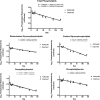Brain phospholipid arachidonic acid half-lives are not altered following 15 weeks of N-3 polyunsaturated fatty acid adequate or deprived diet
- PMID: 19661256
- PMCID: PMC2817583
- DOI: 10.1194/jlr.M000786
Brain phospholipid arachidonic acid half-lives are not altered following 15 weeks of N-3 polyunsaturated fatty acid adequate or deprived diet
Abstract
Previous studies have infused radiolabeled arachidonic acid (AA) into rat brains and followed AA esterification into phospholipids for up to 24 h; however, the half-life of AA in rat brain phospholipids is unknown. Eighteen day old rats were fed either an n-3 PUFA adequate or deprived diet for 15 weeks. Following the 15 weeks, 40 microCi of [(3)H] AA was injected intracerebroventricularly into the right lateral ventricle using stereotaxic surgery and returned to their dietary treatment. From 4-120 days after [(3)H] AA administration, brains were collected for chemical analyses. The half-life of AA in rat brain phospholipids was 44 +/- 4 days for the n-3 PUFA adequate group and 46 +/- 4 days for the n-3 PUFA deprived group, which closely approximates the predicted half-life previously reported, based on the rate of entry from the plasma unesterified pool, suggesting the plasma unesterified pool is a major contributor to brain uptake of AA. Furthermore, unlike a previous report in which the half-life of brain phospholipid docosahexaenoic acid (DHA) was increased in n-3 PUFA deprived rats, n-3 PUFA deprivation did not significantly alter the AA half-life, suggesting different mechanisms exist to maintain brain concentrations of AA and DHA.
Figures

Similar articles
-
Chronic dietary n-6 PUFA deprivation leads to conservation of arachidonic acid and more rapid loss of DHA in rat brain phospholipids.J Lipid Res. 2015 Feb;56(2):390-402. doi: 10.1194/jlr.M055590. Epub 2014 Dec 4. J Lipid Res. 2015. PMID: 25477531 Free PMC article.
-
Half-lives of docosahexaenoic acid in rat brain phospholipids are prolonged by 15 weeks of nutritional deprivation of n-3 polyunsaturated fatty acids.J Neurochem. 2004 Dec;91(5):1125-37. doi: 10.1111/j.1471-4159.2004.02789.x. J Neurochem. 2004. PMID: 15569256
-
Dietary n-6 PUFA deprivation for 15 weeks reduces arachidonic acid concentrations while increasing n-3 PUFA concentrations in organs of post-weaning male rats.Biochim Biophys Acta. 2009 Feb;1791(2):132-9. doi: 10.1016/j.bbalip.2008.11.002. Epub 2008 Nov 27. Biochim Biophys Acta. 2009. PMID: 19073280 Free PMC article.
-
Antagonistic effects of dietary arachidonic acid and n-3 polyunsaturated fatty acids.J Nutr. 1996 Apr;126(4 Suppl):1086S-91S. doi: 10.1093/jn/126.suppl_4.1086S. J Nutr. 1996. PMID: 8642438 Review.
-
Brain arachidonic and docosahexaenoic acid cascades are selectively altered by drugs, diet and disease.Prostaglandins Leukot Essent Fatty Acids. 2008 Sep-Nov;79(3-5):153-6. doi: 10.1016/j.plefa.2008.09.010. Epub 2008 Oct 29. Prostaglandins Leukot Essent Fatty Acids. 2008. PMID: 18973997 Free PMC article. Review.
Cited by
-
Dietary Omega-3 Polyunsaturated Fatty Acid Deprivation Does Not Alter Seizure Thresholds but May Prevent the Anti-seizure Effects of Injected Docosahexaenoic Acid in Rats.Front Neurol. 2019 Feb 5;9:1188. doi: 10.3389/fneur.2018.01188. eCollection 2018. Front Neurol. 2019. PMID: 30804888 Free PMC article.
-
Chronic dietary n-6 PUFA deprivation leads to conservation of arachidonic acid and more rapid loss of DHA in rat brain phospholipids.J Lipid Res. 2015 Feb;56(2):390-402. doi: 10.1194/jlr.M055590. Epub 2014 Dec 4. J Lipid Res. 2015. PMID: 25477531 Free PMC article.
-
Quantifying conversion of linoleic to arachidonic and other n-6 polyunsaturated fatty acids in unanesthetized rats.J Lipid Res. 2010 Oct;51(10):2940-6. doi: 10.1194/jlr.M005595. Epub 2010 Jul 9. J Lipid Res. 2010. Retraction in: J Lipid Res. 2014 May;55(5):991. doi: 10.1194/jlr.M005595ERR. PMID: 20622136 Free PMC article. Retracted.
-
The low levels of eicosapentaenoic acid in rat brain phospholipids are maintained via multiple redundant mechanisms.J Lipid Res. 2013 Sep;54(9):2410-22. doi: 10.1194/jlr.M038505. Epub 2013 Jul 8. J Lipid Res. 2013. PMID: 23836105 Free PMC article.
-
Gabapentin's minimal action on markers of rat brain arachidonic acid metabolism agrees with its inefficacy against bipolar disorder.Prostaglandins Leukot Essent Fatty Acids. 2012 Aug-Sep;87(2-3):71-7. doi: 10.1016/j.plefa.2012.06.003. Epub 2012 Jul 27. Prostaglandins Leukot Essent Fatty Acids. 2012. PMID: 22841517 Free PMC article.
References
-
- Salem N., Jr., Litman B., Kim H. Y., Gawrisch K. 2001. Mechanisms of action of docosahexaenoic acid in the nervous system. Lipids. 36: 945–959. - PubMed
-
- Alessandri J. M., Guesnet P., Vancassel S., Astorg P., Denis I., Langelier B., Aid S., Poumes-Ballihaut C., Champeil-Potokar G., Lavialle M. 2004. Polyunsaturated fatty acids in the central nervous system: evolution of concepts and nutritional implications throughout life. Reprod. Nutr. Dev. 44: 509–538. - PubMed
-
- Demar J. C., Jr., Ma K., Chang L., Bell J. M., Rapoport S. I. 2005. Alpha-linolenic acid does not contribute appreciably to docosahexaenoic acid within brain phospholipids of adult rats fed a diet enriched in docosahexaenoic acid. J. Neurochem. 94: 1063–1076. - PubMed
Publication types
MeSH terms
Substances
LinkOut - more resources
Full Text Sources

